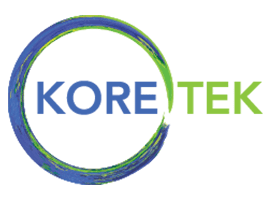As enterprises race to integrate AI into their operations, one critical truth is becoming clear: AI doesn’t just need compute. AI needs a new kind of network.
At Kore-Tek, we work at the frontlines of optical and network engineering. From public sector infrastructure to large-scale enterprise deployments, we’re seeing firsthand how AI is forcing organizations to rethink everything from topology and traffic engineering to segmentation and security. Here are five key learnings from our experience that illustrate why your network may be your biggest AI obstacle.
1. AI workloads break the old network model
Ryan Young, Kore-Tek CEO, puts it plainly. “Most existing networks were built for predictable, transactional traffic. AI is anything but predictable.”
AI traffic is asymmetric and bursty. Predictive AI introduces upstream telemetry. Generative AI demands huge downstream outputs. Agentic AI drives constant east-west traffic. Legacy architectures (especially hub-and-spoke WANs or oversubscribed uplinks) simply weren’t designed for this. And in government or compliance-heavy environments, these gaps are compounded by rigid architectures and outdated QoS models.
2. Capacity is a problem, but so are latency and architecture
Damon Fortune, Board of Advisory Member and Executive Technical Leadership at Kore-Tek, adds, “Many AI systems are latency-sensitive, especially agentic ones. It’s not just about bandwidth. Networks need real-time intelligence.”
Even with more semiconductor technology and better optics, AI workloads can overwhelm networks, not just with volume, but with the timing and direction of traffic. To solve this, you need:
- Real-time telemetry and observability
- Segmented AI traffic as a first-class policy
- Edge inference to cut round-trip delays
- Fabric architectures that support low-latency east-west traffic
3. Security is now an AI problem
AI doesn’t just create more traffic, it increases the attack surface dramatically. Every inference call, every agent-to-agent interaction, every model output is a potential vector. “We’re seeing nearly 30K Common Vulnerabilities and Exposures (CVEs) released in 2024 alone, and adversaries are already using AI to exploit them faster than humans can patch.” said Jeremy Humphrey, Kore-Tek CTO. This is where network-level AI becomes essential:
- Self-healing security policies
- Dynamic segmentation
- Honeypot traps and “flypaper” maneuvers to trap or redirect attacks
- Real-time anomaly detection in optical and IP layers
AI can’t just be a use case. It has to be built into the network fabric itself.
4. Optical networks are becoming the AI nervous system
AI isn’t just a cloud problem. Enterprises need multi-cloud and edge-to-core AI connectivity. That demands:
- Data center interconnects with ultra-low latency
- Optical paths running up to 1.6 Tbps at line rate and have caught up to compute infrastructures
- Edge-to-cloud observability
- AI-assisted traffic routing, healing, and optimization
This means we’re actively deploying these capabilities for clients managing smart infrastructure, IoT, robotics, and mission-critical government systems. Our recommendation is to prioritize speed, intelligence, and adaptability.
5. From automation to augmentation to autonomy
Too many organizations assume they’re “doing AI” because they’ve implemented basic automation or analytics dashboards. But automation isn’t the same as intelligence. Running a script or alerting on thresholds isn’t AI, it’s workflow efficiency. True AI readiness means evolving from manual and rules-based systems toward networks that think, adapt, and recover on their own. That shift requires a deliberate move through three stages:
- Automation: Tasks are scripted or triggered based on static rules. This is the entry point, and it’s where most organizations are today.
- Augmentation: Machine learning models assist human operators by analyzing data patterns, identifying root causes, and suggesting corrective actions. Augmented intelligence improves decision-making and reduces response times.
- Autonomy: AI systems move from support roles to taking action; they provision resources, detect anomalies, remediate failures, and even secure the network without human intervention.
The core capabilities of an autonomous network include:
- Self-Provisioning – AI dynamically allocates bandwidth, routes, or compute based on real-time needs.
- Self-Monitoring – AI observes the full network stack, using telemetry and synthetic traffic to detect issues proactively.
- Self-Healing – When faults occur, AI can reroute traffic, restart services, or apply fixes automatically.
- Self-Remediating – Beyond healing, AI can resolve the root cause, update configurations, or deploy patches.
- Self-Securing – AI detects threats in real-time, isolates impacted segments, and enforces security policies at machine speed. AI-enhanced NDR (Network Detection & Response) systems can identify zero-day threats using behavioral analytics, with Cisco and others reporting 30–40% faster containment using AI.
These capabilities are becoming essential. With AI workloads pushing traffic beyond human-manageable limits and cyber threats accelerating, AI is not just a feature, it’s a foundation for any future-ready network.
These aren’t futuristic ideals. With the right mix of semi-conductor technology, telemetry, and AI-enhanced software, they’re becoming reality. Most organizations lack a strategic focus on the network—treating it as infrastructure, not as a critical enabler of AI success.
In conclusion: your network is a strategic asset
The network is no longer background infrastructure; it’s the foundation of AI success. In a recent study by Cisco, they show:
- 95% of network leaders say resilience is critical to AI success
- AI-powered tools are already improving uptime, agility, and security
- Autonomous infrastructure is the future of networking
This echoes what we at Kore-Tek witness every day: you can’t simply bolt AI onto a legacy network and expect it to deliver. Whether you’re mapping out an AI rollout or already feeling the strain of increased traffic, now is the time to evaluate your infrastructure.
At Kore-Tek, we help organizations redesign their networks to support AI-driven traffic, secure sensitive optical and routing layers, implement self-optimizing and self-healing systems, and connect the dots between public cloud, edge, and private data centers. If you’re serious about AI, it’s time to get serious about your network. Let’s build it right, together.
Read more about networks and AI.
